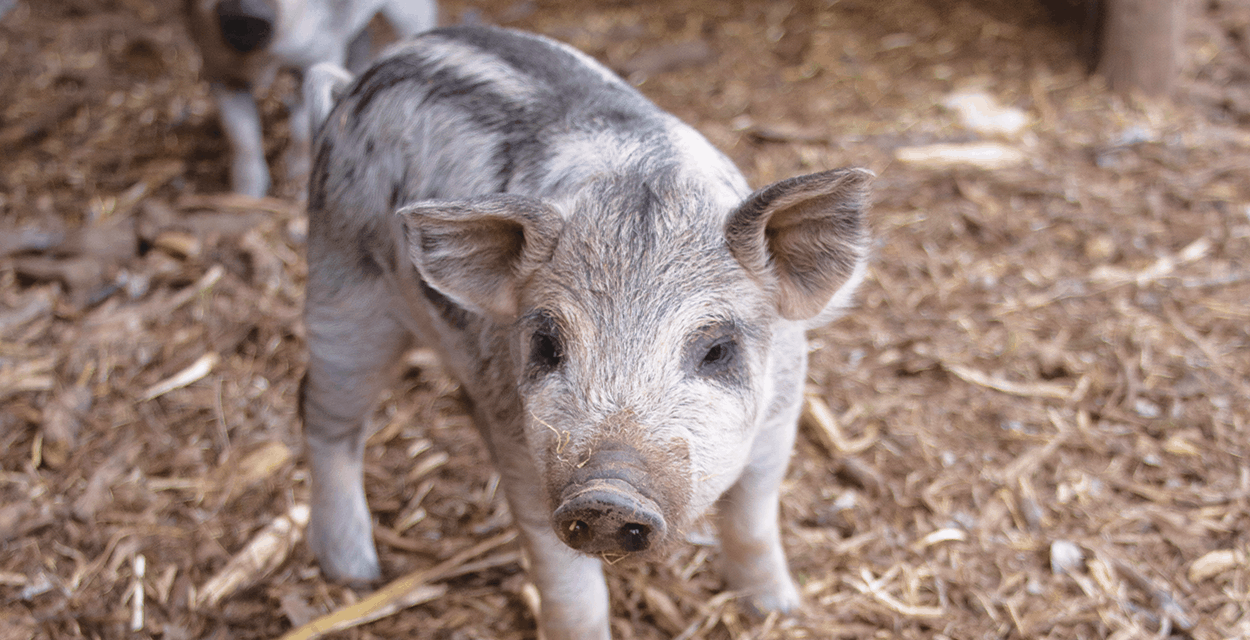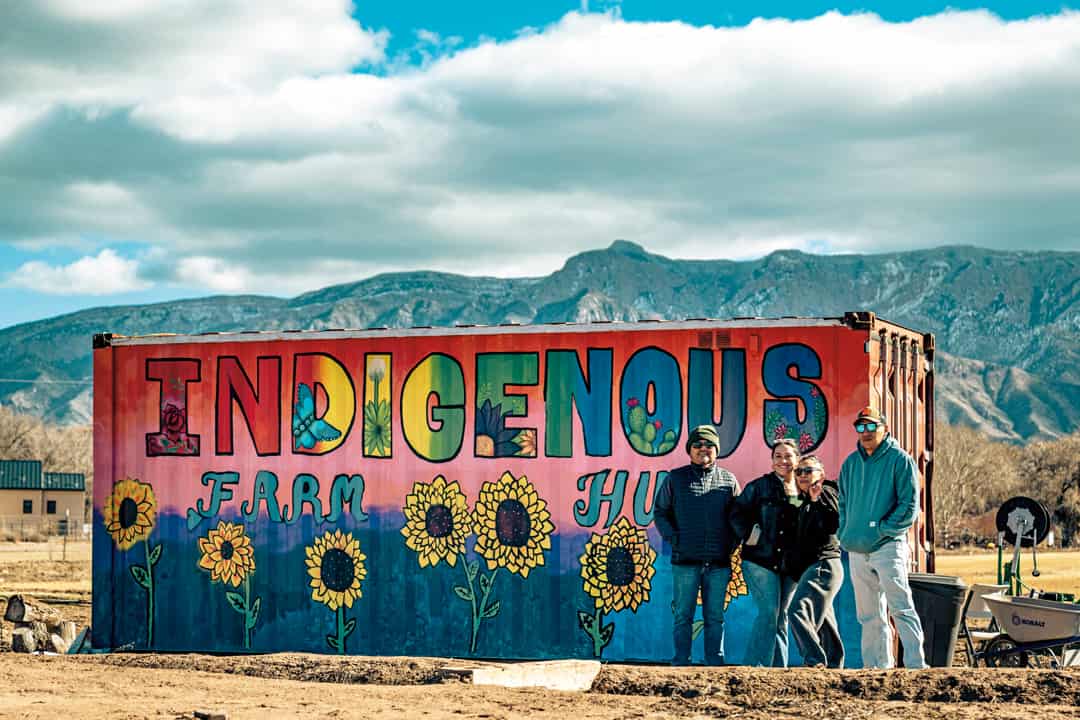Creating an Uncertain Future for the East Mountains
By Michael Dax · Photos by Stephanie Cameron

Purebred Mangalitsa piglets at Polk’s Folly.
It shouldn’t be surprising that one of the most renowned books about New Mexico, John Nichols’s 1974 The Milagro Beanfield War, focuses on a dispute over water. In the book, developers from Albuquerque have come to a fictionalized version of Taos, seeking to build, among other things, a golf course that will cater to out-of-state visitors. As part of this plan, they have cut off local townspeople’s and farmers’ access to water. That is, until one farmer accidentally breaks the valve on an irrigation pipe, spilling water over his beanfield and inciting an at-times humorous rebellion.
Today, a similar, if more nuanced version of this same conflict is playing out in the East Mountains, the collection of towns on the east side of the Sandias. Since the late 1990s, this largely rural, somewhat agrarian community has experienced a growing influx of newcomers from Albuquerque and elsewhere looking for a slice of relaxed country living a stone’s throw from New Mexico’s largest city. Less a wave than a trickle, the suburbanization of the East Mountains has seen punctuated bursts, like the construction of the Paa-ko Communities, a 3,600-acre planned community featuring a twenty-seven hole golf course. More recently, another developer has proposed a similar, four thousand home community across the street from Paa-ko that would have two golf courses and has left longtime residents wondering, where will all the water come from?
As life imitates art, it is perhaps fitting that a somewhat mischievous pig played an outsized role in Nichols’s seminal story, because at the center of this fight are Zach and Ethan Withers, who raise heritage breed hogs at their farm, Polk’s Folly, in San Antonito. Their grandparents bought the land just two years after Nichols’s book hit shelves, and for years they operated the forty acres as a horse farm. Both brothers grew up on the land, but after living in Vermont for nearly a decade, Zach returned three years ago with a desire to farm. Based on the area’s tempestuous weather, a general lack of water, and their small acreage, the brothers decided hogs would be most appropriate for their land, and with this same set of factors in mind, invested in a trio of breeds well suited for the sometimes cold, sometimes dry climate of the East Mountains.
Mangalitsas, a curly-haired breed that originated in the Carpathian Mountains and were originally bred by the Hapsburg Empire, have been referred to as the “Kobe beef of pork.” The brothers also raise a Red Wattle-Duroc cross to take advantage of the Duroc’s ease of handling and the tasty dark meat from the Wattles.
Although their farm operation requires relatively little water, both brothers are concerned for what the area’s future may hold, not just for agriculture, but for anyone hoping to call it home. “I’m way more worried about my kids and grandkids having a reserve of water to pull on in times of extreme drought than I am about being able to irrigate my cornfields,” Zach says, sardonically.
Like almost everyone who lives in the East Mountains, the Withers rely on well water. With no year-round stream or other source of reliable surface water, nearly everyone either collects their water or gets it from a personal well, but recently, more and more residents’ wells have started to go dry.
When I visit in late January, Zach and Ethan point out an empty, grassy bowl—a pit their grandmother dug with a tractor she bought after a lucky night at Bingo. As kids, they remember the grassy bowl filling with spring runoff and remaining full throughout the summer. It served as a refuge for birds as well as a place for them to play and have fun. Last year, however, it filled for only a few days of the year, and although last year’s snowpack was particularly poor, increasingly, the former pond is dry more often than it’s wet.
“There’s a whole number of factors,” says Zach. “Less snowpack, less precipitation in general, and the watershed health has gone down. As you chop it up into smaller pieces, you don’t get the same sort of ecological processes.”
To combat this, the Withers have employed techniques like rotational grazing in order to improve the health of their land and soil. They recognize that their work can only have so much impact on the broader watershed, but for them, it’s a demonstration project they hope others will follow.
For them, the real issue is the number of people. Looking out from the edge of the dry pond, nearly a dozen shining rooftops are visible. When she first moved here as a girl, Zach and Ethan’s mother, Sandi, recalls all of that land being open space. Even more worrisome than the number of people is the lack of regulations. “That guy can sell those two acres, build another house, drill another well,” says Zach, pointing to a new neighbor whose land was recently cut into a five-acre parcel. “There’s no mechanism in place to govern that sort of thing. If you can buy the land and get a building permit, then the Office of the State Engineer will give you a permit for a well regardless of whether there’s water to support that.”

Left: Zach and Ethan Withers of Polk’s Folly. Right: Zach with Big Ben.
On top of this, the aquifer under the East Mountains is complex and difficult to understand. “There are a number of stacked, discrete aquifers,” says Phillip Rust, a hydrogeologist with Bernalillo County.
This has created a scenario where some people’s wells are doing fine while others are going dry. “Some wells are staying static, or barely dropping,” Rust observes. “Yet a few hundred yards away, water levels are dropping eight to ten feet per year, even though there is no real difference in overall use and the wells are drawing upon the same aquifer.” This has made it hard for Rust and other experts to provide guidance to landowners on what to expect in the future, but for the Withers, the answer lies in better awareness among residents about the source of their water. “All the water we get is water that falls out of the sky and hits the ground,” says Zach. “It takes decades, maybe millennia, for it to reach back down to the aquifer. There’s such a disconnect between the way people think about it and the reality of the situation.”
This disconnect is something that Daniel Puccini, founder and owner of Roots Farm Café, sees as well. Puccini grew up in the East Mountains but for a number of years before moving back and opening the farm, café, and education center, Puccini lived and worked at a farm in western North Carolina without any running water. Despite the fact that water was plentiful, he had to haul in all of his drinking water—an experience that forced him not to take for granted how precious water truly is. “We’ve become so spoiled. We don’t realize all the energy that’s going into getting our water here,” says Puccini about living in the East Mountains.
For his part, Puccini has started an education center offering field trips, talks, and workshops to everyone from large school groups to small groups of adults on topics focused on sustainability, from ecology to permaculture. Some programs have a broad focus while others are geared more directly toward helping people develop tools that will allow them to live sustainably and long-term in the region.
For example, since starting the farm roughly six years ago, Puccini has relied solely on what he can capture and store. “It’s not a very good trade-off to grow food for your neighbors when you’re drying up all the water,” he says.
This is why he doesn’t use any well water. In fact, he doesn’t have a well at all. His parents, who live nearby, have had two wells. One went dry thirty years ago, and the second went dry just three years ago. These experiences have been instructive for Puccini, who has learned that relying only on what he can capture will help him live within his means.
Currently, he has about ten thousand gallons of water storage spread across his land, but he hopes to continue to grow that capacity. Because of last year’s abysmal snowpack, he had to let a certain amount of his garden die; he just didn’t have enough water to go around. Moving forward, Puccini hopes to expand and have enough so that the water he collects during the monsoon season will be able to last through the winter.

Red Wattle-Durocs at Polk’s Folly.
Following Puccini’s lead, the Withers brothers are in the process of installing a series of cisterns so they can collect water off every roofline on their property. Likening it to the gold rush that came to the area roughly one hundred years ago, Zach sees the subsequent bust coming—this time driven by the community facing a scarcity of water. “I think long term you’re going to go through a boom-and-bust cycle,” he notes. “You’re going to have to see a huge shift away from groundwater usage.”
While most of the debate within the East Mountains community has pit agriculture and open space against residential development, more and more people are starting to take a closer look at the different kinds of agriculture in the area and their relative sustainability. “It would be worthwhile making some very clear distinctions because talking about agriculture as a whole sum is unproductive,” says Zach. “What we’re doing has absolutely nothing to do with what everyone in Estancia is doing.”
Zach’s invocation of Estancia is in reference to farmers who grow crops like alfalfa and corn using center pivot irrigation, which tends to be inefficient and employ massive quantities of water. Currently, Estancia’s aquifer is in better condition than that of the East Mountains, but with Paa-ko pumping water through a pipeline from that basin to supply its community, looming conflict appears inevitable.
This is an issue that Sarah Wentzel-Fisher, executive director of the Quivira Coalition, an organization focused on sustainable agriculture, recognizes as well. “We’re at a crossroads of thinking about agriculture in this state,” she remarks. “If we are going to prevent being in serious crisis mode, we have to have a cultural shift towards thinking about agriculture as a tool for managing these resources.”
In January, the developers eyeing the Campbell Ranch lost an appeal to access one hundred million gallons of groundwater on the basis that it would impact existing water rights. Many in the community celebrated the victory while knowing that the saga could likely continue. Either way, the larger question has remained unanswered. Regardless of any future large-scale developments, current rates of water usage cannot be sustained.
Puccini and the Withers acknowledge that there’s no silver bullet, but all agree that the answer lies in building a stronger sense of community that will bind people together and encourage them to act like water is the shared resource that it is.
“It needs to start from an awareness of waste and how conservative you can be with water,” says Puccini. Comparing it to the way recycling has become an ingrained, socially policed practice, he continues, “It needs to become second nature.”
In that same vein of creating internal social pressures, the Withers
stress the importance of creating that sense of a shared future.
“Investing a lot in building community and creating the social networks—the mycelium, the interconnectedness—between all people who live here,” says Zach. “If you don’t have that, everything goes to shit.”
Polk’s Folly
polksfolly.com
Roots Farm Cafe 11784 NM-337, Tijeras, 505-900-4118
rootsfarmcafe.com
Edible celebrates New Mexico's food culture, season by season. We believe that knowing where our food comes from is a powerful thing. With our high-quality, aesthetically pleasing and informative publication, we inspire readers to support and celebrate the growers, producers, chefs, beverage and food artisans, and other food professionals in our community.












